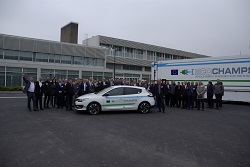Hybrid powertrain innovations set the bar higher for the sector
The current focus on electric vehicles as the cornerstone of future urban mobility shouldn’t make us forget that their hybrid counterparts have a future too – and that this future is now. With electric vehicle range and a lack of charging infrastructure still being a problem, hybrid vehicles are likely to become the preferred solution for travelling beyond city limits, but on one condition: the development of easy to integrate, cost-efficient hybrid powertrain technology. The ECOCHAMPS (European COmpetitiveness in Commercial Hybrid and AutoMotive PowertrainS) project was created with this requirement in mind. Since May 2015, the 25-strong consortium – which includes light- and heavy-duty vehicle manufacturers FIAT, Renault, Daimler, Iveco, MAN and DAF Trucks – has been working on solutions to improve powertrain efficiency by up to 20 %, reduce powertrain weight and volume by up to 20 % and, broadly speaking, make hybrid vehicles more cost-effective. The results of the project, which include a modular system and standardisation framework for hybrid electric drivetrain components and auxiliaries for commercial vehicles (available on the project website), a set of electric components for hybrid powertrains, and optimised drivelines, have been demonstrated in two light-duty and three commercial vehicles at TRL 7. These vehicles are a FIAT 500X, a Renault Megane, a medium-duty commercial truck, a city bus and a heavy tractor. Guus Arts, coordinator of the project on behalf of DAF Trucks, discusses its outcomes and importance for the future of mobility in Europe. What would you say is the way forward in powertrain innovation? Current powertrains with combustion engines are highly efficient already. Further improvements without the addition of new technology such as, for instance, electric machines in the case of a hybrid powertrain, are hardly possible. What would be the advantages of such hybrid powertrains? Hybrid powertrains, as developed within the ECOCHAMPS project, can use green (locally produced) electrical energy, have zero emission driving capability for urban areas and still have enough range for longer trips. Furthermore, they currently have a more attractive cost premium compared to full electric battery powered vehicles due to their smaller, optimised battery size. Can you tell us more about the technology you developed? The vehicles developed in ECOCHAMPS all share a common trait: they combine highly efficient combustion engines with a rightsized e-motor and battery. In addition, the three heavy-duty vehicles created during the project use standardised hybrid electric components which are, as much as possible, based on high-volume passenger car technology. Furthermore, the standards developed in the project, which help cost-effective hybrid component development, are publicly available for adoption by the European automotive industry, standardisation institutes and their technical committees. You worked on five different demonstration vehicles. How did you select them? The variety of vehicle applications was one of the main criteria, to assure maximum know-how transfer between the different market segments. We also wanted to show the various ways a plug-in hybrid powertrain could be specified and optimised to meet the needs of the end user. What would you say were the most important outcomes of these demonstrations? Certainly the increased powertrain efficiency, the enhanced vehicle functionalities and the reduced cost premium for the hybrid powertrains. The latter was achieved, in part, since the powertrains are based on optimal specifications in general, standardisation where possible and the use of passenger car technology for heavy-duty vehicles in particular. What are your expectations in terms of performance and environmental impact? Plug-in hybrid vehicles should be specified to meet the needs of the end customers. For the ECOCHAMPS hybrid vehicles, their performance in general has been improved to comply with customer needs as defined in the beginning of the project. Hence, the vehicles must provide the full electric driving range required for the desired operating distance in urban areas, and positively impact air quality at the lowest possible cost. In cases where vehicles are driven almost exclusively in cities, a full electric vehicle might be a better alternative. But the vehicles developed within the ECOCHAMPS project have increased functionality, to allow both urban and non-urban operation, giving flexibility to their users. What are your follow-up plans, notably with regards to commercialisation? It is always difficult to speak about exact dates when it comes to commercialisation. As the ECOCHAMPS powertrains are developed at TRL 7, the project can be seen as a stepping stone towards market introduction, meaning that the powertrain concepts can be expected on the market in the mid-term. But the learning from the project goes beyond just the technology demonstrators. The experience gained and new standards and processes devised during the project are already finding application in the next round of vehicle development activities.
Countries
Netherlands



